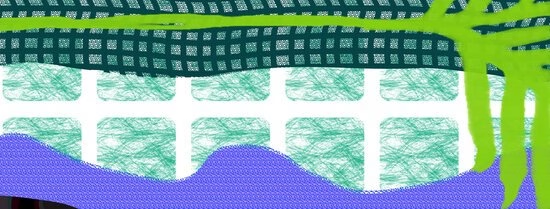Our Story
Throughout time, textiles have served as the common red thread between all kinds of women from different cultures, countries and even time periods. For example, the ancient goddess Athena, a master weaver who infused the world with her great knowledge and wisdom, reflects the women who bond and share profound knowledge through the craft until this day. As the experienced weaver deftly interlocks and combines her many threads to create one beautiful carpet of colors, our art collects and shares stories to create pieces of multidimensional and diversified narratives. It saddens us then, that there are still preconceptions about the textile craft as a legit artform. Especially with the contemporary emphasis on more corporate and digital art styles, it almost seems that the space for textile orientated art becomes smaller and smaller. It is this development that we try to challenge in our work.
What drew us to L4E
What drew us to the project was the interdisciplinary character of Learning for Equality. More specifically, we saw the interdisciplinary mapping of students’ experiences through their skills and knowledge as a powerful way to reclaim narrative and provide a platform for others to let their voices be heard. Centered around giving students a voice, we wanted to contribute by giving a ‘face’ to the Learning For Equality project.
Activism, knowledge exchange and representation.
It was the collective and, in our view, protopian stance of the project toward inclusivity and diversity that we wanted to highlight within the illustrations. For the artworks, we saw the relationship between the students, the campus and the city as an ecosystem and interpreted the infinite quest for betterment as the need for activism and change. We took motifs and inspiration from the 1960’s and 70’s, a period renowned for its activist movements. Vitality and dynamism were quintessential during this period and were expressed through growth, flower power, waves and movement. Naturally, in the spirit of our own practice, the mediums and fabrics used served as a language on their own. Through using textiles that are culturally significant for us, such as batik and ikat, we wanted to communicate that representation of any kind can extend beyond the content and into the format it is presented in.
In the design of the logo, we carried on the message of representation through the incorporation of various iconography such as flags, flowers and historic landmarks placed upon the speech bubbles, another running theme in the illustrations. The speech bubbles, protest signs, books and so on, are our way of visualizing the communication and knowledge exchange of the project; they remain an overarching motif through all illustrations. A motif that we hope will grow in the future as the project maps out what Learning For Equality entails.
All in all, we were very grateful to have been part of the project and work with the wonderful people behind it. We hope that it will inspire many others to share their experiences, skills and knowledge in the future.
Conversation with Alana and Louise Wieland on inclusive design

